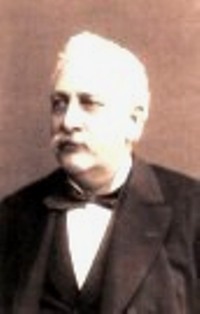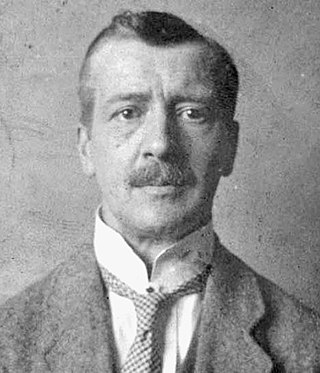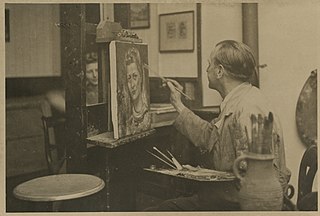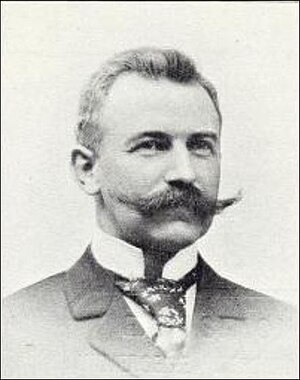
The Hague School is a group of artists who lived and worked in The Hague between 1860 and 1890. Their work was heavily influenced by the realist painters of the French Barbizon school. The painters of the Hague school generally made use of relatively somber colors, which is why the Hague School is sometimes called the Gray School.
Thierry Veltman was a Dutch painter, sculptor, ceramist, graphic artist and art educator. He focused in particular on figures and still life.

Wolter Robert Baron van Hoëvell was a Dutch minister, politician, reformer, and writer. Born into nobility and trained in the Dutch Reformed Church, he worked for eleven years as a minister in the Dutch East Indies. He led a Malay-speaking congregation, engaged in scholarly research and cultural activities, and became an outspoken critic of Dutch colonialism. His activism culminated when he acted as one of the leaders of a short-lived protest in 1848. During the event, a multi-ethnic group of Batavian inhabitants presented their grievances to the local government. As a result of his leadership in the protest, van Hoëvell was forced to resign his position in the Indies.
Hermanus (Herman) Berserik was a Dutch painter and print maker. He was a member of the Pulchri Studio in The Hague. He studied art at that city's Royal Academy of Art, where his teachers included Willem Schrofer, Willem Jacob Rozendaal, and Rein Draijer.
De Witt is the name of an old Dutch patrician and regenten family. Originally from Dordrecht, the genealogy of the family begins with Jan de Witte, a patrician who lived around 1295. The family have played an important role during the Dutch Golden Age. They were at the centre of Dordrecht and Holland oligarchy from the end of the 16th century until 1672, and belonged to the Dutch States Party.

Abraham Hulk Senior was an Anglo-Dutch painter, draughtsman and lithographer. He initially trained as a portraitist, but became a well-known as a marine-painter and the patriarch of a whole family of Anglo-Dutch artists.

John Ricus Couperus was a Dutch lawyer, member of the Council of Justice in Padang, member of the High Military Court of the Dutch East Indies and the landheer of Tjikopo. He was also the father of the Dutch writer Louis Couperus and knight in the Order of the Netherlands Lion.

Jacob Jan van der Maaten was a Dutch painter and etcher. Van der Maaten was a pupil of Hendrikus van de Sande Bakhuyzen and studied at the Royal Academy of Art, The Hague. In 1852 he became a member of the Royal Academy of Fine Arts in Amsterdam. Later, Van der Maaten became teacher at the so-called King's School in Apeldoorn (1866–1879).

Pieter Abramsen was a Dutch sculptor, and visiting professor at the Delft University of Technology, known for his work in which abstraction and realism are joined.

Jan Hillebrand Wijsmuller was a Dutch painter. He belongs to The 2. Golden Age of Dutch Painting.

Willink van Collenprijs is a former Dutch art award, which was awarded for the first time in 1880 by the Sociëteit Arti et Amicitiae. It was intended as an encouragement award for young artists, and was considered as a national counterpart to the Paris Salon. Its existence of more than 71 years proves the success of Amsterdam's art policy. For many of its winners, it was a valuable boost to their careers in the Dutch art world. Some of the prize winners were also recognized abroad and remain well known today.
Teunis (Teun) Jacob was a Dutch wall painter and sculptor, who lived and worked in Rotterdam since the early 1950s. He made both figure and nonrepresentational art.

Franz Wilhelm Maria Deutmann was a Dutch painter and photographer. He was a member of Arti et Amicitiae and is considered to be part of the Laren School, an offshoot of the Hague School, which is an independent part of the international movement of impressionism.

Hermanus Willem Koekkoek was a Dutch painter, illustrator and watercolorist. He worked in several genres, but is best known for his military art.

Constant Cornelis Huijsmans was a Dutch art teacher and painter, whose roots go back to the seventeenth-century Antwerp of the landscape painter Cornelis Huysmans (1648–1727). Paintings of the latter are to be found at the Louvre in Paris and at the Hermitage Museum in Saint Petersburg, Russia. Earlier generations of the Huijsmans family used to spell their family name slightly differently, as Huysmans.
Judith Maria Ten Bosch is a Dutch painter and illustrator.

Jos Croin was a Dutch painter. His work was part of the painting event in the art competition at the 1924 Summer Olympics. Croin's work was included in the 1939 exhibition and sale Onze Kunst van Heden at the Rijksmuseum in Amsterdam.

Johanna Berhardina Midderigh-Bokhorst (1880–1972) was a Dutch illustrator.

The Exhibition of Living Masters was the name given to a series of exhibitions of contemporary art, held in various cities in the Netherlands, from 1808 to 1917.

Nicolaas Pieneman was a Dutch artist.


















